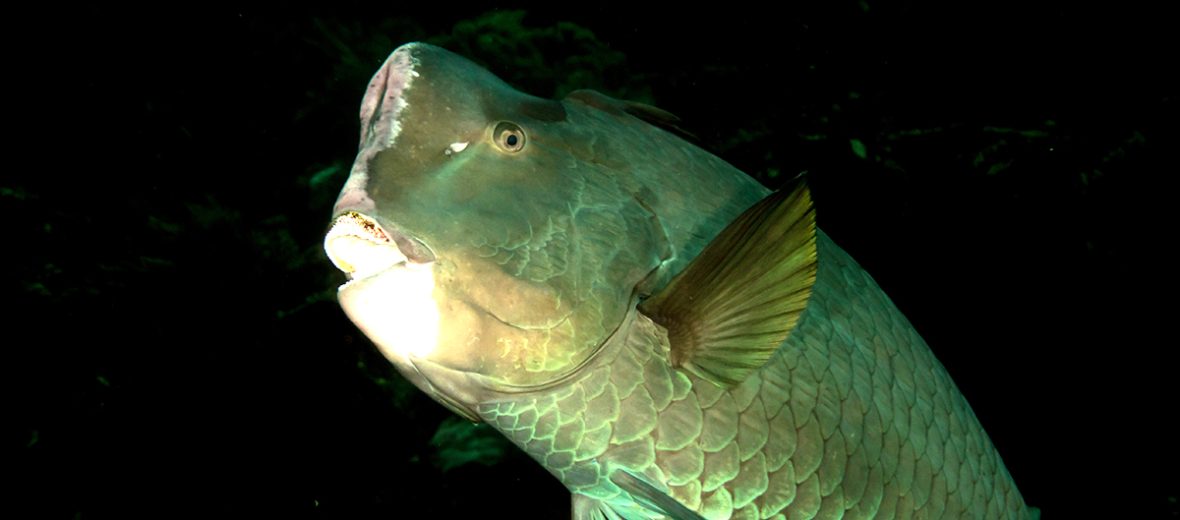
The green humphead parrotfish, aka humphead parrotfish, bumphead parrotfish, double-headed parrotfish, buffalo parrotfish, and giant parrotfish, hails from various reefs of the Indian and Pacific Oceans. They can be found from the Red Sea in the west to Samoa in the east and also from the Yaeyama Islands in the north to the Great Barrier Reef, in Australia, in the south. The humphead parrotfish is threatened by overfishing and intrusion by human activities. These fish are currently listed as Vulnerable by the IUCN. Their numbers are also decreasing.
First the Stats…
Scientific name: Bolbometopon muricatum
Weight: Up to 165 lbs.
Length: Up to 4.9 feet
Lifespan: Up to 40 years
Now on to the Facts!
1.) They are considered the largest herbivorous fish living in the coral reefs.
2.) Unfortunately, they have low reproduction and replenishment rates, which makes it harder for them to bounce back when their populations are depleted. They can take upwards of 10 years to reach adulthood.
3.) These fish are gregarious and can be found in groups of over 75 individuals.
4.) Green humphead parrotfishes feast on benthic algae and live corals.
5.) Using their prominent hump, they will ram against coral structures to break off pieces in order to feed on them.
But wait, there’s more on the green humphead parrotfish!
6.) Their grinding up of coral contributes to the sand on local beaches that border reefs.
7.) This constant grinding up of coral causes significant bioerosion of reefs.
Did you know…?
These parrotfish can ingest upwards of 5 tons of coral per year, per individual!
8.) The habitats of juveniles are subjected to being degraded by poor water quality. For instance by run-off of sediments from logging.
9.) Juveniles are a drab color, while adults are a beautiful green. This drab coloration aids in camouflage.
10.) Green humphead parrotfishes dwell in harems, with 1 dominant male watching over a group of females. He ferociously defends his territory from other nearby males, using his impressive size and strength to keep his harem.
But wait, there’s still more on the green humphead parrotfish!
11.) As they feast on coral, they also eat algae that can otherwise easily smother the reef. This helps to keep the coral healthy and aids in the growth of new coral colonies.
12.) Their beak is actually made of ever-growing teeth that need to be worn down so that they can continue to be able to eat.
Did you know…?
They have the ability to communicate with one other using electrical signals. These signals are believed to be used for a variety of purposes, like aggression, courtship, and territorial defense.
13.) These fish are diurnal (active during the day).
14.) At night, green humphead parrotfishes create a slimy, mucus cocoon around themselves for protection while they sleep. This cocoon also assists in trapping plankton, which provides them with an extra morning meal when they wake up to start their day.
15.) They often dwell within other shoals of reef fishes, like surgeonfish and tangs. These large groups of fish work together to locate food and assist each other in evading predators.
But wait, there’s still a little more on the green humphead parrotfish!
16.) Juveniles have the ability to change their coloration and patterning to mimic other fish, like toxic butterflyfish. This interesting trick helps them avoid predation.
17.) Healthy populations of green humphead parrotfish are important for attracting divers and snorkelers to coral reefs. This helps the local economies.
Did you know…?
Parrotfish have up to 15 rows of 1,000 teeth fused together into a shape that forms their trademark beak.
18.) Featured in native stories and songs, these parrotfish are symbols of power, prosperity, and strength.
19.) While not common in aquariums, due to their size and specific dietary needs, some larger public aquariums do house these beautiful fish. While living in these aquariums, they can serve as ambassadors for conservation.
20.) Spawning typically occurs in the morning in reef passages, en-masse, in a process known as “lek mating”. Males will typically bash their heads against one another to defend their territories and put on shows as females pass by.
But wait, there’s still a tad more on the green humphead parrotfish!
21.) Reproduction occurs by the light of a full moon.
22.) Females release eggs into the water that are fertilized by the males.
23.) The females will release thousands of eggs each spawn.
Now a Short Green Humphead Parrotfish Video!
Be sure to share & comment below! Also, check out the Critter Science YouTube channel. Videos added regularly!
Want to suggest a critter for me to write about? Let me know here.
Some source material acquired from: Wikipedia & IUCN
Photo credit: Rickard Zerpe



